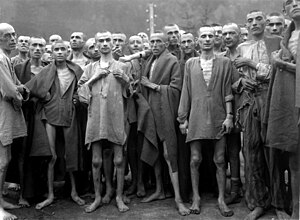Wels is a city in Upper Austria, on the Traun River near Linz. It is the county seat of Wels-Land, and with a population of approximately 60,000, the eighth largest city in Austria.

Mauthausen was a concentration camp that first appeared in 1938, and the original Mauthausen camp was not situated precisely on the same spot as the latter more commonly known Mauthausen opened 20 years later. The latter Mauthausen was situated on a hill above the market town of Mauthausen, Upper Austria. It was the main camp of a group with nearly 100 further subcamps located throughout Austria and southern Germany. The three Gusen concentration camps in and around the village of St Georgen/Gusen, just a few kilometres from Mauthausen, held a significant proportion of prisoners within the camp complex, at times exceeding the number of prisoners at the Mauthausen main camp.

The Loibl Pass or Ljubelj Pass is a high mountain pass in the Karawanks chain of the Southern Limestone Alps, linking Austria with Slovenia. The Loibl Pass road is the shortest connection between the Carinthian town of Ferlach and Tržič in Upper Carniola and part of the European route E652 from Klagenfurt to Naklo.

Raxwerke or Rax-Werke was a facility of the Wiener Neustädter Lokomotivfabrik at Wiener Neustadt in Lower Austria. During World War II, the company also produced lamps for Panzer tanks and anti-aircraft guns. Two Raxwerke plants employed several thousand forced laborers from the Mauthausen-Gusen concentration camp.
The Steyr-Münichholz concentration camp was one in a number of subcamps of the Mauthausen-Gusen concentration camp in Upper Austria. Inmates were drawn from the main camp, in order to exploit their labor for producing arms in Steyr-Daimler-Puch corporation factories, and to build air-raid bunkers in the town of Steyr.

Wilhelm Heckmann was a German concert and easy listening musician. From 1937 to 1945, he was imprisoned in the Nazi concentration camps in Dachau and Mauthausen. Heckmann founded the first prisoner band in Mauthausen, and was also instrumental in the founding of the large prisoner orchestra there.

The Mühlviertler Hasenjagd was a war crime in which 500 Soviet officers, who had revolted and escaped from the Mühlviertel subcamp of Mauthausen-Gusen concentration camp on 2 February 1945, were hunted down. Local civilians, soldiers and local Nazi organizations hunted down the escapees for three weeks, summarily executing most of them. Of the original 500 prisoners who took part in the escape attempt, eleven succeeded in remaining free until the end of the war. It was the largest escape in the history of the Nazi concentration camps.

V-2 rocket facilities were military installations associated with Nazi Germany's V-2 SRBM ballistic missile, including bunkers and small launch pads which were never operationally used.

The Redl-Zipf V-2 rocket facility located in central Austria between Vöcklabruck and Vöcklamarkt and established in September 1943 began operation for V-2 rocket motor testing after Raxwerke test equipment had been moved from Friedrichshafen.
Rudolf Anton Haunschmied is an Austrian author and local historian.
Kazimierz Smoleń was a Polish political prisoner of the Nazi World War II KZ Auschwitz, and later a long-term director of Auschwitz-Birkenau State Museum.
The following is a timeline of the history of the city of Vienna, Austria.
The city of Vienna, Austria is home to a long-established Czech population. During the time of the Austro-Hungarian Empire in the late 1800s and early 1900s, Czechs were the largest non-German speaking population in Vienna. After the fall of the Austro-Hungarian Empire and the independence of Czechoslovakia, many of the Viennese Czechs returned to their homeland. Today, Vienna is home to a small Czech population that has grown in numbers since the Czech Republic's admission to the European Union in 2004.

Granitwerke Mauthausen was one of the names used by the DEST company for its branch based in Sankt Georgen an der Gusen and which exploited the slave manpower confined in certain subcamps of the Mauthausen-Gusen concentration camp system: Gusen I, Gusen II, Gusen III, and Mauthausen.
The following is a timeline of the history of the city of Linz, Austria.

Gusen was a subcamp of Mauthausen concentration camp operated by the SS between the villages of Sankt Georgen an der Gusen and Langestein in the Reichsgau Ostmark. Primarily populated by Polish prisoners, there were also large numbers of Spanish Republicans, Soviet citizens, and Italians. Initially, prisoners worked in nearby quarries, producing granite which was sold by the SS company DEST.

The Zipf Brewery is a brewery in the Upper Austrian municipality of Neukirchen an der Vöckla. It is named after its location in the Zipf division and is part of Brau Union Österreich AG, the majority of whose shares are owned by Heineken.












